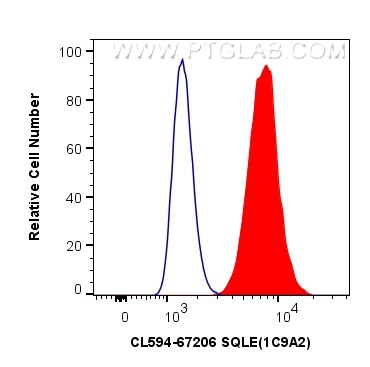Anticorps Monoclonal anti-SQLE
SQLE Monoclonal Antibody for FC (Intra)
Hôte / Isotype
Mouse / IgG2a
Réactivité testée
Humain, porc, rat
Applications
FC (Intra)
Conjugaison
CoraLite®594 Fluorescent Dye
CloneNo.
1C9A2
N° de cat : CL594-67206
Synonymes
Galerie de données de validation
Applications testées
| Résultats positifs en cytométrie | cellules HepG2 |
Dilution recommandée
| Application | Dilution |
|---|---|
| Flow Cytometry (FC) | FC : 0.40 ug per 10^6 cells in a 100 µl suspension |
| It is recommended that this reagent should be titrated in each testing system to obtain optimal results. | |
| Sample-dependent, check data in validation data gallery | |
Informations sur le produit
CL594-67206 cible SQLE dans les applications de FC (Intra) et montre une réactivité avec des échantillons Humain, porc, rat
| Réactivité | Humain, porc, rat |
| Hôte / Isotype | Mouse / IgG2a |
| Clonalité | Monoclonal |
| Type | Anticorps |
| Immunogène | SQLE Protéine recombinante Ag3266 |
| Nom complet | squalene epoxidase |
| Masse moléculaire calculée | 574 aa, 64 kDa |
| Poids moléculaire observé | 50-64 kDa |
| Numéro d’acquisition GenBank | BC017033 |
| Symbole du gène | SQLE |
| Identification du gène (NCBI) | 6713 |
| Conjugaison | CoraLite®594 Fluorescent Dye |
| Excitation/Emission maxima wavelengths | 588 nm / 604 nm |
| Forme | Liquide |
| Méthode de purification | Purification par protéine A |
| Tampon de stockage | PBS avec glycérol à 50 %, Proclin300 à 0,05 % et BSA à 0,5 %, pH 7,3. |
| Conditions de stockage | Stocker à -20 °C. Éviter toute exposition à la lumière. Stable pendant un an après l'expédition. L'aliquotage n'est pas nécessaire pour le stockage à -20oC Les 20ul contiennent 0,1% de BSA. |
Informations générales
SQLE, also named as ERG1, SE and SM, belongs to the squalene monooxygenase family. It catalyzes the first oxygenation step in cholesterol synthesis, acting on squalene before cyclization into the basic steroid structure. SQLE may serve as a flux-controlling enzyme beyond 3-hydroxy-3-methylglutaryl-coenzyme A reductase (HMGR, considered as rate limiting). It is also posttranslationally regulated by cholesterol-dependent proteasomal degradation. SQLE is subject to feedback regulation via cholesterol-induced degradation, which depends on its lipid-sensing N terminal regulatory domain. Truncation of SQLE occurs during its endoplasmic reticulum-associated degradation and requires the proteasome, which partially degrades the SQLE N-terminus and eliminates cholesterol-sensing elements within this region. The MW of SQLE is about 50-64 kDa. (PMID:21356516, PMID: 28972164)
Protocole
| Product Specific Protocols | |
|---|---|
| FC protocol for CL594 SQLE antibody CL594-67206 | Download protocol |
| Standard Protocols | |
|---|---|
| Click here to view our Standard Protocols |


